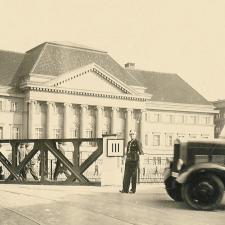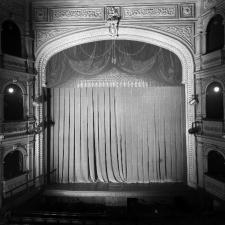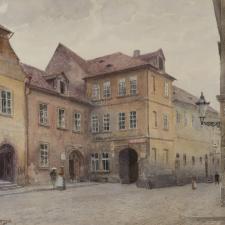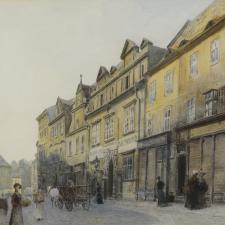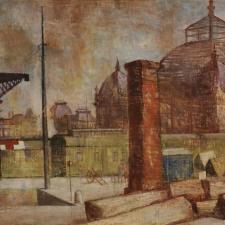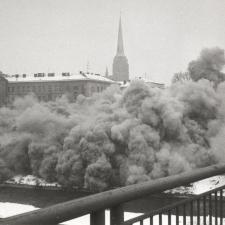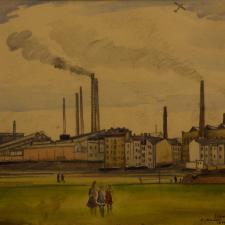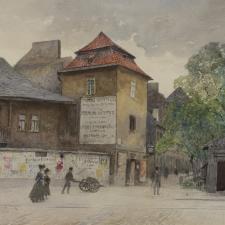By means of historical paintings from the collections of the Gallery of West Bohemia, photographs, models and a wide range of documents, the exhibition evokes buildings and whole city parts that disappeared or have undergone significant changes.
It should not be a mere documentation of architectonic, artistic or urbanistic loses of the city. The aim of the exhibition is to remember the development of relation of the experts and broad public to these values including the history of efforts put to the protection of monuments and landscape. The exhibition takes place at the occasion of the hundredth anniversary of publication of the book Pilsen Lost in 1917. While preparing the exhibition, the Gallery of West Bohemia in Pilsen has cooperated with the professionals of the Museum of West Bohemia in Pilsen and with the professionals of the National Heritage Institute, Regional Office in Pilsen; in addition, the documents have been provided from the Pilsen City Archives and from private collections.
City Development before 1850
New Pilsen was founded at the end of the 13th century on a site with no previous residential structures. This allowed the demarcation of a regular chessboard style ground plan, which has been preserved in its broad outlines to this day, including the allotments. From the outset, suburbs formed along the roads coming out of its four gates. The original look of Pilsen and its suburbs has been eroded away by numerous periods of transformation caused sometimes by wars or natural disasters, and at other times by an increase in city wealth and fluctuations in housing demand. In the 1520s and 1530s the city was unsuccessfully besieged several times by Hussite troops. Suburban buildings perished during these events and had to be rebuilt. The city itself was affected by a series of arson attacks in 1507. The 16th century, on the other hand, was a period of prosperity. During the second half of the century the Renaissance style broke through and completely changed the face of the originally gothic city. Pilsen was conquered for the first time in 1618, at the beginning of the Thirty Years War. The suburbs once again burned down and were partially replaced by a new Baroque fortification. The city was exhausted by the war and stagnated until the 17th century. Renovations began after the year 1700, when the Baroque style dominated in Pilsen. The face of the city was influenced by the Josephine reforms, when two of the three monasteries and city cemeteries were closed down and the education system and municipal administration were modified. At the end of the 18th century Pilsen lost its function as a fortification; however, the demolition of fortifications and the opening of the city to its surroundings sped up as late as around the first quarter of the 19th century. This period is associated with the burgomaster Martin Kopecký (1828–1850) and his successful efforts to modernise the city. During this period the city was in a transitional state, when its area was similar to that in the Middle Ages, but the population was already on the increase and the conditions were evolving to allow for accelerated growth in the second half of the 19th century.
The Historical Centre as a Specific City Space 1850–2016
Changes in the approach to monuments can be observed in examples typical for the individual phases of the observed period. Enthusiasm for the industrial revolution and the effort to transform Pilsen into a modern city in the middle of the 19th century led to a disregard for the centuries-old values of the old city. The demolition of the Gothic Říhovský House on the square is a symbol of this time period. The main wave of economic emancipation in the city, significantly underway from the 1880s, brought with it unprecedented pressure on the transformation of historical buildings into much larger apartment houses or palaces of important institutions. The former image of the city with its traditional dominant features changed dramatically – during that time period, Pilsen excluded itself from the list of Gothic-Renaissance Czech historical towns. Official monument preservation was ensured by conservationists from the Imperial and Royal Central Committee, who worked rather formally. An essential turnabout occurred in 1909 with the establishment of the Friends of Antiques Circle, grouped around the enthusiast Ladislav Lábek. Since then, positive changes could be seen in the public perception of monuments. One symbolic structure was the Gerlachovský House, which was saved from demolition before the First World War thanks to the Circle and impeccably repaired by the city to serve as the newly established Ethnographic Museum. For the historical centre of Pilsen, the whole First Republic period can be perceived as cultivated and calm, despite the filling in of the Mill Race at the beginning of the era. World War II also had a minimal impact on the monuments of the city centre; even the intense allied bombing, with one exception, evaded the city centre. Society-wide changes after 1948 were also associated with monuments. According to proclamations they should have been perfectly care for; however, this did not include buildings constructed in the previous, capitalist time period. Most of the buildings in Pilsen originated from this very period, which, at the beginning of the 1950s, was the reason for the failure of the first proposition to declare a local conservation area. Although the first heritage law came into force at the end of this decade, there was still a great loss of heritage in the historical centre. The demolition of almost an entire block of historical buildings, including Baroque Salt House in Sedláčkova Street, is a representation of such thoughtlessness. In the following years it became clearer that the proclamation and reality conflicted with each other almost completely. The socialist regime absolutely failed to manage the necessary maintenance and the historical centre fell into a dismal state of disrepair. In 1989, after the reassessment of attitudes towards modern architecture, the city centre became a conservation area, and the following years opened the way for the restoration of individual houses and public spaces.
The Development of the City outside the Historical Centre 1850–2016
In Pilsen urbanism, the third quarter of the 19th century represented the negation of the previous, generous era of Martin Kopecký, when the medieval city opened up to the greenery of public parks and private gardens. The absence of quality rules for the development of Pilsen, and a completely inadequate purview of the new management, in a time of intense construction of industrial companies and railway networks, often led even to the vandalism of the city and its conservation and landscape potential. As well as the establishment of a Building Authority, the opening of a German state industrial school in Pilsen was also of breakthrough importance for the increase in construction. For Pilsen, the last decade of the 19th century represents an unprecedented level of development, especially the creation of new infrastructures, founded for the needs of the entire subsequent century. However, even in this era there was no improvement in the attitude towards city construction as a whole. This occurred in 1905, probably thanks to Matouš Mandl and Vojtěch Kapsa joining the city administration. Regulatory plans were recast on completely new and more generous principles. Although many shortcomings can be found in the interwar period, even in architecture and urbanism, this period can be clearly assessed as the most beneficial since the times of Martin Kopecký, even to this day. Pilsen was progressively not only developed, but also revitalised into a relatively well functioning and attractive city. Even the dramatic end of 1938, when Pilsen became a city on a new international border, did not lead to changes in the approach to city urbanism. During the war, the initial advantages characterised by the presence of the Škoda factory, such as better living conditions for employees, became a problem and Pilsen became a dangerous focal point. Pilsen, mostly the Škoda arms factory, became a target for allied air strikes. Despite the total destruction of several hundred houses and damage to other buildings and areas, including parts of the city infrastructure, the air strikes did not destroy the city structure. The most important parts escaped almost unscathed.
Circles of experts in Pilsen at that time shared the same point of view – the city as a whole had to be planned in a new and different way. However, preparations began after the communist putsch, when discussions on other options and new trends ended. Planning was assigned to Jindřich Krise and František Sammer, who designed the city in a generous and modern way. Their solution for the city centre, however, was a fundamental problem; they left it sandwiched between a pair of gigantic industrial plants and reconstructed two of the most important crossroads in the region into a modern traffic interchange, leaving its location in the centre unchanged. They did not recognize the value of the historical city outside the centre; they proposed its almost complete demolition and the construction of new districts with almost no residential buildings. The first half of the 1960s can be considered crucial for the further destiny of Pilsen urbanism. From 1962, a team of project architects led by Zbyněk Tichý worked on another proposal for a Pilsen ground plan. Although Tichý used his recent experiences from Western Europe, he did not consider that the situation there was changing. He did not take into consideration warnings of the dangers of urban traffic engineering in central city areas and based his plan on principles taken almost two decades previously from Kris and Sammer. Another problem was commitment of the 11th congress of the Communist Party of Czechoslovakia (KSČ) in June 1958, when they promised to build more than one million flats in Czechoslovakia by 1970. The building of first high-rise estates was subsequent to the demolition of countless historical buildings. The fact that similar processes of blanket demolition also began at several places in the centre was much more serious. The overall impression of Pilsen in the 1960s was, however, quite positive, because, so far, these vigorous encroachments had only affected a minority, and new beneficial buildings had even appeared. In contrast, the so-called Normalization period can be considered the worst period in the history of Pilsen urbanism, and architecture in general. The attention of officials turned to building housing estates in Severní předměstí (the Northern Suburbs) and in the centre of Pilsen. Unmaintained buildings had become so dilapidated that there were blanket demolitions on an unprecedented scale. The new buildings not only provided zero compensation, but by their character often further deepened the devastation of the area. The worst encroachment was the construction of an east-west through road, creating a several-kilometre long suburban chasm through the city.
The society-wide changes that took place after November 1989 also brought great hope to Pilsen urbanism. We are witness to an extraordinary process, when private owners, along with the municipality and other institutions, have brought many areas of the city centre and the suburbs out of hopelessness and into rejuvenation. Heritage preservation initiated the protection of many buildings and locations, as well as the knowledge of advanced city development. A whole range of positive changes show Pilsen’s potential, although many problems still remain. So far, the city has not been able to overcome the fact that the overall image of Pilsen gives the impression of certain randomness and, above all, it is still not able to deal with its greatest issue, that of its damaged wider city centre.
|
|





